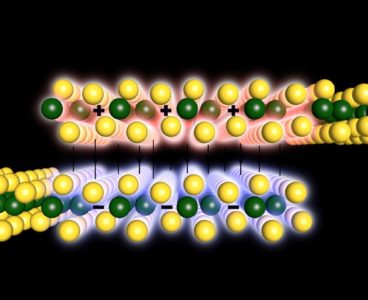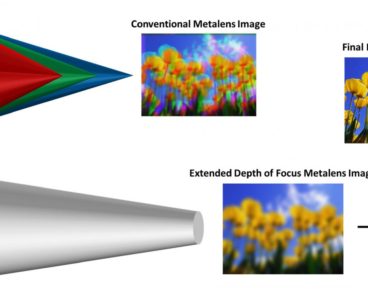Future technologies based on the principles of quantum mechanics could revolutionize information technology. But to realize the devices of tomorrow, today’s physicists must develop precise and reliable platforms to trap and manipulate quantum-mechanical particles. In a paper published Feb. 25 in the journal Nature, a team of physicists from the University of Washington, the University…
Two-Dimensional Materials Skip the Energy Barrier by Growing One Row at a Time
A new collaborative study led by a research team at the Department of Energy’s Pacific Northwest National Laboratory, University of California, Los Angeles and the University of Washington could provide engineers new design rules for creating microelectronics, membranes and tissues, and open up better production methods for new materials. At the same time, the research,…
Diving Robots Find Antarctic Winter Seas Exhale Surprising Amounts of Carbon Dioxide
More than 100 oceanic floats are now diving and drifting in the Southern Ocean around Antarctica during the peak of winter. These instruments are gathering data from a place and season that remains very poorly studied, despite its important role in regulating the global climate. A new study from the University of Washington, the Monterey…
The 2D Form of Tungsten Ditelluride is Full of Surprises
The general public might think of the 21st century as an era of revolutionary technological platforms, such as smartphones or social media. But for many scientists, this century is the era of another type of platform: two-dimensional materials, and their unexpected secrets. These 2-D materials can be prepared in crystalline sheets as thin as a…
Harmful Dyes in Lakes, Rivers Can Become Colorless With New, Sponge-Like Material
Dyes are widely used in industries such as textiles, cosmetics, food processing, papermaking and plastics. Globally, we produce about 700,000 metric tons — the weight of two Empire State Buildings — of dye each year to color our clothing, eye shadow, toys and vending machine candy. During manufacturing, about a tenth of all dye products…
A Promising Target in the Quest for a One-Million-Year-Old Antarctic Ice Core
Ice cores offer a window into the history of Earth’s climate. Layers of ice reveal past temperatures, and gases trapped in bubbles reveal past atmospheric composition. The oldest continuous ice core so far comes from Dome C in East Antarctica and extends back 800,000 years. But a tantalizing clue recently offered the possibility to go…
The First Wireless Flying Robotic Insect Takes Off
Insect-sized flying robots could help with time-consuming tasks like surveying crop growth on large farms or sniffing out gas leaks. These robots soar by fluttering tiny wings because they are too small to use propellers, like those seen on their larger drone cousins. Small size is advantageous: These robots are cheap to make and can…
Atomically Thin Magnetic Device Could Lead to New Memory Technologies
Magnetic materials are the backbone of modern digital information technologies, such as hard-disk storage. A University of Washington-led team has now taken this one step further by encoding information using magnets that are just a few layers of atoms in thickness. This breakthrough may revolutionize both cloud computing technologies and consumer electronics by enabling data…
Screen Reader Plus Keyboard Helps Blind, Low-Vision Users Browse Modern Webpages
Browsing through offerings on Airbnb means clicking on rows of photos to compare options from prospective hosts. This kind of table-based navigation is increasingly central to our digital lives – but it can be tedious or impossible for people who are blind or have low vision to navigate these modern webpages using traditional screen readers.…
Peptide-Based Biogenic Dental Product may Cure Cavities
Researchers at the University of Washington have designed a convenient and natural product that uses proteins to rebuild tooth enamel and treat dental cavities. The research finding was first published in ACS Biomaterials Science and Engineering. “Remineralization guided by peptides is a healthy alternative to current dental health care,” said lead author Mehmet Sarikaya, professor…
Glaciers in Mongolia’s Gobi Desert Actually Shrank During the Last Ice Age
The simple story says that during the last ice age, temperatures were colder and ice sheets expanded around the planet. That may hold true for most of Europe and North America, but new research from the University of Washington tells a different story in the high-altitude, desert climates of Mongolia. The recent paper in Quaternary…
Beluga Whales Dive Deeper, Longer to Find Food in Arctic
Reductions in sea ice in the Arctic have a clear impact on animals such as polar bears that rely on frozen surfaces for feeding, mating and migrating. But sea ice loss is changing Arctic habitat and affecting other species in more indirect ways, new research finds. Beluga whales that spend summers feeding in the Arctic…
Hybrid Optics Bring Color Imaging Using Ultrathin Metalenses into Focus
For photographers and scientists, lenses are lifesavers. They reflect and refract light, making possible the imaging systems that drive discovery through the microscope and preserve history through cameras. But today’s glass-based lenses are bulky and resist miniaturization. Next-generation technologies, such as ultrathin cameras or tiny microscopes, require lenses made of a new array of materials.…
Scale-Eating Fish Adopt Clever Parasitic Methods to Survive
Think of them as extra-large parasites. A small group of fishes — possibly the world’s cleverest carnivorous grazers — feeds on the scales of other fish in the tropics. The different species’ approach differs: some ram their blunt noses into the sides of other fish to prey upon sloughed-off scales, while others open their jaws…
How Babies’ Brains Process Touch Builds Foundations for Learning
Touch is the first of the five senses to develop, yet scientists know far less about the baby’s brain response to touch than to, say, the sight of mom’s face, or the sound of her voice. Now, through the use of safe, new brain imaging techniques, University of Washington researchers provide one of the first…
Living Cell Membranes Can Self-Sort Their Components by ‘Demixing’
Cells — the building blocks of our bodies — are encapsulated by membranes. The same goes for the specialized compartments within our cells. These membranes are extremely thin, oily films, containing proteins and fatty molecules called lipids. For decades, scientists have argued about how cell membranes organize and maintain distinct regions enriched in particular protein…
Mountain Glaciers Shrinking Across the West
Until recently, glaciers in the United States have been measured in two ways: placing stakes in the snow, as federal scientists have done each year since 1957 at South Cascade Glacier in Washington state; or tracking glacier area using photographs from airplanes and satellites. We now have a third, much more powerful tool. While he…
Flexible ‘Skin’ Could Enhance Abilities of Robots, Prosthetics to Perform Everyday Tasks
New App Uses Smartphone Selfies to Screen for Pancreatic Cancer
Pancreatic cancer has one of the worst prognoses — with a five-year survival rate of 9 percent — in part because there are no telltale symptoms or non-invasive screening tools to catch a tumor before it spreads. Now, University of Washington researchers have developed an app that could allow people to easily screen for pancreatic…
Probiotics Help Poplar Trees Clean Up Toxins in Superfund Sites
Trees have the ability to capture and remove pollutants from the soil and degrade them through natural processes in the plant. It’s a feat of nature companies have used to help clean up polluted sites, though only in small-scale projects. Now, a probiotic bacteria for trees can boost the speed and effectiveness of this natural…
DNA Sequencing Tools Lack Robust Protections Against Cybersecurity Risks
Rapid improvement in DNA sequencing has sparked a proliferation of medical and genetic tests that promise to reveal everything from one’s ancestry to fitness levels to microorganisms that live in your gut. A new study from University of Washington researchers that analyzed the security hygiene of common, open-source DNA processing programs finds evidence of poor…
Team Develops Fast, Cheap Method to Make Supercapacitor Electrodes
UW team develops fast, cheap method to make supercapacitor electrodes for electric cars, high-powered lasers Supercapacitors are an aptly named type of device that can store and deliver energy faster than conventional batteries. They are in high demand for applications including electric cars, wireless telecommunications and high-powered lasers. But to realize these applications, supercapacitors need…
Scientists ‘Closing The Gap’ on Malaria in India
The National Institutes of Health has renewed a major grant that funds a University of Washington-led research center to understand malaria in India. The initiative — Malaria Evolution in South Asia, which was first funded in 2010 — is one of 10 NIH-supported International Centers of Excellence for Malaria Research, or ICEMRs. The National Institute of…
To Connect Biology with Electronics, Be Rigid, Yet Flexible
The problem is a fundamental incompatibility in communication styles. That conclusion might crop up during divorce proceedings, or describe a diplomatic row. But scientists designing polymers that can bridge the biological and electronic divide must also deal with incompatible messaging styles. Electronics rely on racing streams of electrons, but the same is not true for…
Scientists Discover a 2D Magnet
Magnetic materials form the basis of technologies that play increasingly pivotal roles in our lives today, including sensing and hard-disk data storage. But as our innovative dreams conjure wishes for ever-smaller and faster devices, researchers are seeking new magnetic materials that are more compact, more efficient and can be controlled using precise, reliable methods. A…

























